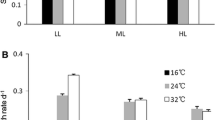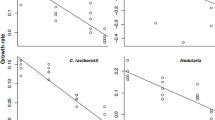Abstract
In the present study, we aimed to demonstrate that allelopathic compounds from the cyanobacterium Phormidium sp. can induce the collapse of large populations of the cyanobacteria Microcystis aeruginosa Kützing Kützing. We employed several strains of this toxic cyanobacteria, from six different locations, in order to test for adaptive variation in resistance to allelochemicals. As a preliminary test to detect allelopathic effect, we performed bioassays with Phormidium allelochemicals against the different strains of M. aeruginosa at low population abundances. Then, we combined long-term competition experiments and mechanistic modelling with two purposes: (a) demonstrate that the inhibitory effect of Phormidium sp. against M. aeruginosa was due to allelopathy and not resource competition; (b) test the effectiveness of these allelochemicals at inducing the collapse of large populations of M. aeruginosa. Our results showed a strong allelopathic effect of Phormidium, which induced the collapse of large populations of M. aeruginosa, without evidence of differences in sensitivity between strains. We demonstrated that allelopathy (interference competition) can reverse the outcome predicted by resource competition (exploitation competition). These results are encouraging in order to take further steps in the development of a bioremediation method, based in Phormidium allelopathy, against blooms of toxic cyanobacteria.





Similar content being viewed by others
Data availability
Enquiries about data availability should be directed to the authors.
References
Anderson, D. M., P. M. Glibert & J. M. Burkholder, 2002. Harmful algal blooms and eutrophication: Nutrient sources, composition and consequences. Estuaries 25(4b): 704–726.
Antunes, J., S. Pereira, T. Ribeiro, J. E. Plowman, A. Thomas, S. Clerens, A. Campos, V. Vasconcelos & J. R. Almeida, 2019. A multi-bioassay integrated approach to assess the antifouling potential of the cyanobacterial metabolites portoamides. Marine Drugs 17(2): 1–19.
Barreiro, A. & V. M. Vasconcelos, 2014. Interactions between allelopathic properties and growth kynetics in four freshwater phytoplankton species studied by model simulations. Aquatic Ecology 48: 191–205.
Barreiro, A., S. Roy & V. M. Vasconcelos, 2018. Allelopathy prevents competitive exclusion and promotes phytoplankton biodiversity. Oikos 127(1): 85–98.
Barreiro et al., 2022 . Bottom-up regulation of allelopathy and population dynamics of an experimental two-species community.
Carey, C. C., B. W. Ibelings, E. P. Hoffmann, D. P. Hamilton & J. D. Brookes, 2012. Eco-physiological adaptations that favour freshwater cyanobacteria in a changing climate. Water Research 46(5): 1394–1407.
Chao, L. & B. R. Levin, 1981. Structured habitats and the evolution of anticompetitor toxins in bacteria. Proceedings of the National Academy of Sciences USA 78: 6324–6328.
Chen, J., H. Zhang, Z. Han, J. Ye & Z. Liu, 2012. The influence of aquatic macrophytes of Microcystis aeruginosa growth. Ecological Engenereeing 42: 130–133.
Cobo, F., 2015. Métodos de control de las floraciones de cianobacterias en aguas continentales. Limnetica 34(1): 247–268.
Durret, R. & S. Levin, 1997. Allelopathy in spatially distributed populations. Journal of Theoretical Biology 185: 165–171.
Ellner, S. P., Y. Seifu & R. H. Smith, 2002. Fitting Population Dynamic Models to Time-Series Data by Gradient Matching. Ecology 83(8): 2256–2270.
Flores, E., J. E. Frías, L. M. Rubio & H. Antonia, 2005. Photosynthetic nitrate assimilation in cyanobacteria. Photosynthesis Research 83: 117–133.
Gross, E., H. Meyer & G. Schilling, 1996. Release and Ecological Impact of Algicidal Hydrolysable Polyphenols in Myriophyllum Spicatum. Phytochemistry 41: 133–138.
Huisman, J., J. Sharples, J. Stroom, P. Visser, W. A. Kardinaal, J. M. Verspagen & B. Sommeijer, 2004. Changes in turbulent mixing shift competition for light between phytoplankton species. Ecology 85(11): 2960–2970.
Jørgensen, S., W. Löffler, & M. Straškraba, 2005. Lake and Reservoir Management. Vol. 54. Developments in Water Science. Elsevier, Amsterdam.
Kolmakov, V., 2006. Methods for prevention of mass development of the cyanobacterium Microcystis aeruginosa Kutz emend Elenk. In Aquatic Systems. Microbiology 75(2): 115–118.
Leão, P.N., A. R. Pereira, W. T. Liu, J. Ng, P. A. Pevzner, P. C. Dorrestein, G. M. König, V. M. Vasconcelos, W. H. Gerwick, 2010. Synergistic allelochemicals from a freshwater cyanobacterium. Proceedings of the National Academy of Sciences of the United States of America 107(25): 11183–11188. https://doi.org/10.1073/pnas.0914343107
Levenberg, K., 1944. A method for the solution of certain non-linear problems in least squares. Quarterly of Applied Mathematics 2(2): 164–168.
Li, J., R. Li & J. Li, 2017. Current research scenario for microcystins biodegradation – A review on fundamental knowlenge, application prospects and challenges. Science of the Total Environment 595: 615–632.
Matthijs, H.C.P., P. M. Visser, B. Reeze, J. Meeuse, P.C. Slot, G. Wijn, R. Talens, J. Huisman, 2012. Selective suppression of harmful cyanobacteria in an entire lake with hydrogen peroxide. Water Research 46(5): 1460–1472. https://doi.org/10.1016/j.watres.2011.11.016
Ma, J., J. D. Brookes, B. Qin, H. W. Paerl, G. Gao, P. Wu, W. Zhang, J. Deng, G. Zhu, Y. Zhang, H. Xu & H. Niu, 2014. Environmental factors controlling colony formation in blooms of the cyanobacteria Microcystis spp. In Lake Taihu. China. Harmful Algae 31: 136–142.
Manson, C., 2002. Biology of Freshwater Pollution, Vol. 4. Pearson Education, England.
Monteiro, N., J. Cuaresma, V. Vasconcelos & A. Barreiro, 2021. Competitive exclusion of toxic cyanobacterial species by an allelopathic strain of Phormidium. Aquatic Ecology. https://doi.org/10.1007/s10452-021-09901-1.
Nakai, S., Y. Inoue, M. Hosomi & A. Murakami, 2000. Myriophyllum spicatum-released allelopathic polyphenols inhibiting growth of blue-green algae Microcystis aeruginosa. Water Research 34(11): 3026–3032.
Nelder, J. A. & R. Mead, 1965. A simplex method for function minimization. The Computer Journal 7: 308–313.
Paerl, H., et al., 2016. It takes two to tango: when and where dual nutrient (N & P) reductions are needed to protect lakes and downstream ecosystems. Environmental Science and Technology 50(20): 10805–10813.
Qin, B., et al., 2007. Environmental issues of Lake Taihu, China. Hydrobiologia 581: 3–14.
Redfield, A. C, 1934. On the Proportions of Organic Derivatives in Sea Water and Their Relation to the Composition of Plankton. James Johnstone Memorial Volume, University Press of Liverpool 176–192.
Ribeiro, T., F. Lemos, M. Preto, J. Azevedo, M. L. Sousa, P. N. Leao, A. Campos, S. Linder, R. Vitorino, V. Vasconcelos & R. Urbatzka, 2017. Cytotoxicity of portoamides in human cancer cells and analysis of the molecular mechanisms of action. PLoS ONE 12(12): e0188817.
Roy, S., 2009. The coevolution of two phytoplankton species on a single resource. Allelopathy as a pseudo-mixotrophy. Theoretical Population Biology 75: 68–75.
R Core Team, 2022. R: A language and environment for statistical computing. R Foundation for Statistical Computing, Vienna, Austria. https://www.R-project.org/
Sigee, D., R. Glenn, M. Andrews, E. Bellinger, R. Butler, H. Epton & R. Hendry, 1999. Biological Control of Cyanobacteria: Principles and Possibilities. Hydrobiologia 396: 161–172.
Sondergaard, M., K. Wolter & W. Ripl, 2002. Chemical Treatment of Water and Sediments with Special Reference to Lakes. Handwbook of Ecological Reforestation 1: 185–205.
Sousa, M. L., T. Ribeiro, V. Vasconcelos, S. Linder & R. Urbatzka, 2020. Portoamides A and B are mitochondrial toxins and induce cytotoxicity on the proliferative cell layer of in vitro microtumours. Toxicon 175: 49–56.
Steffen, M. M., et al., 2017. Ecophysiological Examination of the Lake Erie Microcystis Bloom in 2014: Linkages between Biology and the Water Supply Shutdown of Toledo, OH. Environmental Science and Technology 51(12): 6745–6755.
Tan, X., H. Gu, Y. Ruan, J. Zhong, K. Parajuli & J. Hu, 2019. Effects of nitrogen on interspecific competition between two cell-size cyanobacteria: Microcystis aeruginosa and Synechococcus sp. Harmful Algae 89: 101661.
Tilman, D., 1977. Resource competition between plankton algae: an experimental and theoretical approach. Ecology 58(2): 338–348.
Visser, P., B. Ibelings, M. Bormans & J. Huisman, 2016. Artificial mixing to control cyanobacterial blooms: a review. Aquatic Ecology 50(3): 423–441.
Wang, Z., D. Li, H. Qin & Y. Li, 2012. An integrated method for removal of harmful cyanobacterial blooms in eutrophic lakes. Environmental Pollution 160: 34–41.
Wang, B., Q. Song, J. Long, G. Song, W. Mi & Y. Bi, 2019. Optimization method for Microcystis bloom mitigation by hydrogen peroxide and its stimulate effects on growth of chlorophytes. Chemosphere 228: 505–512.
Wolter, K, 1994. “Phosphorus Precipitation” in Restoration of Lake Ecosystem – A Holistic Approach, ed M. Eiseltova (Wetlands International-european Association), 63–68.
Acknowledgements
We are very thankful to M. Vale, J. Morais, R. Silva, J. Azevedo and P. Reis for their valuable technical support. This work was funded by NOVELMAR Project—Novel marine products with biotechnological applications (Grant No. NORTE-01-0145-FEDER-000035) for supporting this work, funded by FCT (Foundation for Science and Technology, Portugal). ABF was also funded by contract from FCT. We are also very thankful to two anonymous reviewers whose comments and suggestions greatly improved this manuscript.
Author information
Authors and Affiliations
Contributions
AVP and MAP—performed research, data analysis and wrote the manuscript. ABF—designed research, performed data analysis and wrote the manuscript, VV—designed research and wrote the manuscript.
Corresponding author
Ethics declarations
Conflict of interest
The authors declare that the research was conducted in the absence of any commercial or financial relationships that could be construed as a potential conflict of interest.
Additional information
Handling Editor: Luigi Naselli-Flores
Publisher's Note
Springer Nature remains neutral with regard to jurisdictional claims in published maps and institutional affiliations.
Supplementary Information
Below is the link to the electronic supplementary material.
Rights and permissions
About this article
Cite this article
Pando, Á.V., Pires, M.A., Vasconcelos, V. et al. Phormidium sp. allelochemicals induce the collapse of large populations of different genotypes of Microcystis aeruginosa. Hydrobiologia 849, 3213–3226 (2022). https://doi.org/10.1007/s10750-022-04926-5
Received:
Revised:
Accepted:
Published:
Issue Date:
DOI: https://doi.org/10.1007/s10750-022-04926-5




